A History of the County of York North Riding: Volume 1. Originally published by Victoria County History, London, 1914.
This free content was digitised by double rekeying. All rights reserved.
'Parishes: Kirkby Sigston', in A History of the County of York North Riding: Volume 1, ed. William Page (London, 1914), British History Online https://prod.british-history.ac.uk/vch/yorks/north/vol1/pp405-409 [accessed 1 February 2025].
'Parishes: Kirkby Sigston', in A History of the County of York North Riding: Volume 1. Edited by William Page (London, 1914), British History Online, accessed February 1, 2025, https://prod.british-history.ac.uk/vch/yorks/north/vol1/pp405-409.
"Parishes: Kirkby Sigston". A History of the County of York North Riding: Volume 1. Ed. William Page (London, 1914), British History Online. Web. 1 February 2025. https://prod.british-history.ac.uk/vch/yorks/north/vol1/pp405-409.
In this section
KIRKBY SIGSTON
Sigheston (xi cent.); Siggeston (xiv cent.); Kyrkebesiggeston (xv cent.).
The parish of Kirkby Sigston lies east of Northallerton and covers about 3,400 acres. It consists of three townships, Kirkby Sigston itself, Sowerby under Cotcliffe to the south of it, and Winton Stank and Hallikeld to the north. In none of these townships is there a village properly so called. The population is scattered through the parish in farm-houses, the only industry being agriculture. About 1,200 acres are in cultivation, the chief crops being wheat, barley, oats and peas; the greater part of the land, however, is devoted to pasture, the amount of woodland being very small. (fn. 1) The subsoil of this parish is Lower Lias.
The great high road from Thirsk to Yarm runs through the south-east corner of Kirkby Sigston township, and where it meets the eastern boundary a lane branches westward. At this point stands Jeater Houses, a hamlet partly in Kirkby Sigston parish and partly in Osmotherley. It was once the home of jet workers. From Jeater Houses the road leads to another small hamlet, Sigston Smithy, where is the post office for the whole parish, and still running westward the road crosses the Cod Beck at Sigston Bridge. On the right bank of the river is the moated site of the old castle of Sigston, the residence of the lords of the manor in the 14th century. To the south of the castle is the church of St. Lawrence, built on a slight ridge and approached by a raised pathway from the rectory, which is situated a little to the west amid a clump of trees. Near the church is the school. Sigston Manor House is a square stonefaced 18th-century building standing on the road half a mile to the east of the church. From the rectory a lane runs south to the grange of Sowerby.
A field-path leads north-west to Stank Hall, once the residence of a branch of the Lascelles family. The present farm-house is but a small portion of the original building, the foundations of which have been met with under the adjoining yard. It is a rectangular structure two stories high, having an arched doorway in the centre, with an ornamental key and moulded imposts and jambs. The windows were originally mullioned and transomed, but with one exception these have been replaced by modern sashes. The walls are finished with a stone cornice and stand on a plinth. Above a blocked door at one end of the house is a carved stone bearing a shield with mantling and crest and the date 15(8)5. The arms are: Sable a cross paty or, for Lascelles, impaling Or a cheveron gules a chief vair, for St. Quintin of Harpham, with the crest of a muzzled bear's head. These are the arms of Thomas Lascelles (died 1618). On the opposite side of the building are traces of a large walled garden, with what were probably small circular pavilions at the angles.
Manors
KIRKBY SIGSTON at the time of the Domesday Survey was soke of the royal manor of Northallerton (fn. 2) (q.v.), with which it passed to the Bishops of Durham. The bishops held the overlordship of half a knight's fee till it fell into abeyance. Courts were held in Kirkby Sigston by their sheriffs. (fn. 3)
Kirkby Sigston was divided between two holdings as early as the beginning of the 13th century, when a quarter of a knight's fee was held by Michael son of Michael and a second quarter by Henry Walens. This second quarter had been given by Hugh Pudsey, Bishop of Durham (1153–95), to Walter de Farlington, whose daughter and heir Bishop Philip de Poitou (1197–1208) married to Henry Walens. (fn. 3a) Margaret daughter of Henry Walens married William son and heir of Philip Colvill, (fn. 4) and must have brought him this part of Sigston. William Hairun, who in or about 1242 quitclaimed to his overlord the bishop his claim on the manors of Sigston, Ellerbeck and Foxton, (fn. 5) was the son of Jordan Hairun, a tenant in Thimbleby, and presumably here also, in the 12th century. (fn. 6) Michael son of Michael was probably the father of John son of Michael de Ryhill, husband of Joan Colvill. (fn. 7) In 1284 half the vill was held by Michael de Ryhill and half by William Colvill. (fn. 8) The descent of the Colvill portion of the estate followed the descent of the manor of Dale Town (fn. 9) (q.v.) into the possession of the Mauleverer family. It was quitclaimed in 1478 by Edmund Mauleverer to Ralph Pigot, the holder of the other half of the manor, (fn. 10) and presumably followed the descent of the latter from that date.
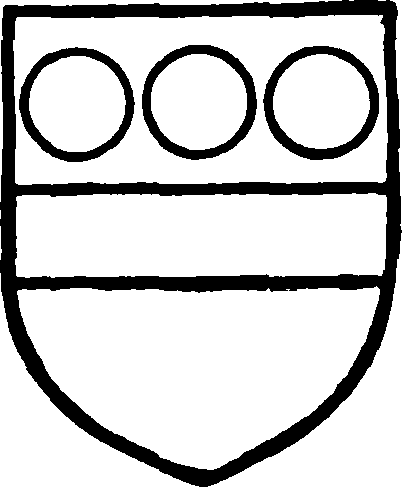
Colvill. Or a fesse gules with three roundels gules in the chief.
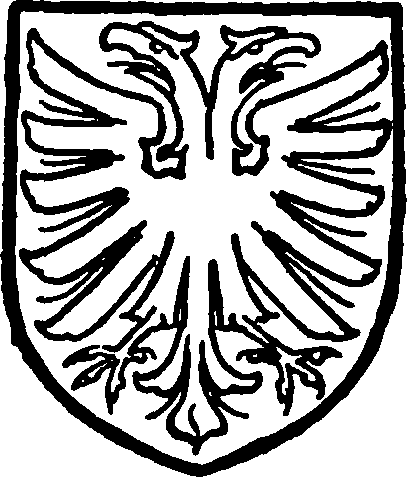
Sigston. Argent an eagle sable with two heads.

Sywardby. Argent a bend cotised between six lions sable.
From the Ryhills is traced the descent of the family of Sigston, lords of the manor here in the 14th century. In 1313 John son of John son of Michael was lord of Sigston, (fn. 11) and it seems probable that he was the grandson of the Michael de Ryhill who was holding 3 carucates in 1284–5. (fn. 12) He married Joan daughter of Henry Maunsell, (fn. 13) and had a son John de Sigston, tenant of the manor in 1327. (fn. 14) 'John son of John,' lord of Sigston in 1348, (fn. 15) died without issue and the estate passed to his sister Joan wife of Thomas Place. (fn. 16) Her son John died without heirs, and, after passing through three generations in the family of her second son William, the manor was inherited by the family of Sywardby through William's sister Margaret wife of William Sywardby. (fn. 17) In 1433 an assize was brought against William Sywardby, son of Margaret, by Robert Wadesley, who was descended from the Sigstons through Agnes, a sister of John de Sigston, lord of the manor in 1327, on the ground that the reversion of the manor belonged after the Place family to the Wadesleys and not to the Sywardbys. (fn. 18) The verdict was given against him, and the Sywardbys remained in possession, the manor being inherited by Margaret daughter of William Sywardby the younger, who married Geoffrey Pigot. (fn. 19) They were succeeded by their son Ralph Pigot, to whom the other moiety of the manor was quitclaimed in 1478. (fn. 20) Ralph Pigot died childless in 1503, (fn. 21) and his estates were divided among the three daughters of his brother Thomas, Margaret wife of James Metcalfe, Joan, who married first Sir Giles Hussey and afterwards Sir Thomas Folkingham, and Elizabeth, who married successively Sir James Strangways, Sir Charles Brandon, and Francis Nevill. (fn. 22)

Slingsby of Scriven, baronet. Argent a griffon sable with a fesse gules athwart him.
That part of Kirkby Sigston which fell to the share of the second sister Joan was inherited by her son Thomas Hussey, (fn. 23) who was attainted for his part in the Rebellion of the Earls in 1570. (fn. 24) He was 'stoutly and manfully apprehended in the field' by George Lamplough, (fn. 25) to whom his lands were subsequently granted as reward. (fn. 26) George Lamplough was succeeded in 1588 by Edward his son. (fn. 27) Edward died in 1594, leaving Kirkby Sigston to his son George, (fn. 28) who was still in possession in 1622. (fn. 29) In 1641 Benjamin Tiffin, possibly a mortgagee, released the manor to Lord Fauconberg. (fn. 30) The manor appears among the lands of Lord Fauconberg when they were registered as those of a delinquent in 1648, (fn. 31) and in 1652 when they were sequestered by a Parliamentary Committee. (fn. 32) In 1654 he sold the manor to John and William Turner, (fn. 33) and it was settled on the latter in 1674. (fn. 34) This family remained in possession till the middle of the 18th century. William Turner was lord of the manor in 1736, (fn. 35) John Turner in 1738. (fn. 36) The latter had four daughters and coheirs, the eldest of whom married Charles Slingsby. (fn. 37) The shares of all four came by purchase into the possession of Sir Thomas Turner Slingsby of Scriven, son of Charles, and eighth baronet. (fn. 38) His grandson Sir Charles Slingsby was drowned while crossing the River Ure with a hunting party in 1869. His sister and heir Emma Louisa Catherine, wife of Captain Leslie, took the name of Slingsby, as did her cousin the Rev. Charles Atkinson, who succeeded on her death in 1899. (fn. 38a) He was killed in a hunting accident on 14 November 1912. His heir is his son Charles Reynard Slingsby.
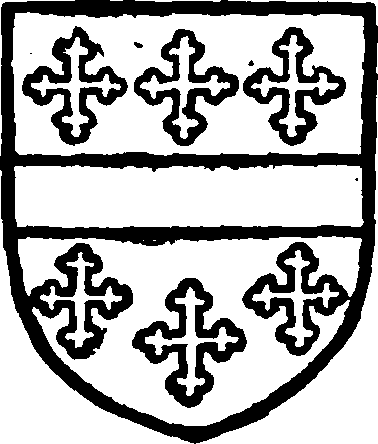
Laton. Argent a fesse between six crosslets sable.
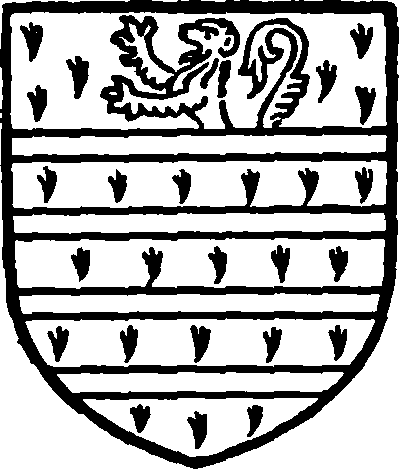
Frewen. Ermine four bars azure with a demilion in his proper colours in the chief.
The share of Margaret Pigot was inherited in 1531 by her son Christopher Metcalfe. (fn. 39) One of his sisters married Thomas Laton of Sexhowe, (fn. 40) and Sir Christopher conveyed to him the various tenements and lands in Sigston, which constituted his share of the estate. (fn. 41) Charles Laton, the son and heir of Thomas Laton, acquired also the share of the youngest Pigot sister, Elizabeth, who with her third husband Francis Nevill conveyed to him the reversion of it in 1578. (fn. 42) Thus the Laton family had a considerable estate here, which they continued to hold till the latter part of the 17th century. Charles Laton settled it in 1613 (fn. 43) on his son and heir Thomas, who with his second wife Bridget was in possession in 1650. (fn. 44) Their grandson Charles son of Thomas held the manor ten years afterwards, (fn. 45) but died without issue, and it was inherited by his sister and heir Bridget, who married Thomas Frewen. (fn. 46) Their son Laton Frewen inherited his mother's lands and left them to his son Laton Frewen, who took the name of Turner when he inherited the estates of the Turners of Cold Overton. (fn. 47) At his death his lands in Kirkby Sigston passed to his cousin Thomas Frewen, (fn. 48) and still remain part of the family estates. (fn. 49)
WINTON was among the lands of the Bishop of Durham in 1086, (fn. 50) when it was waste. Down to the middle of the 14th century no one tenant seems to have held the whole manor. In 1284–5 Stephen Maunsell held half a carucate of Henry Maunsell, who held of the bishop. Four oxgangs were held of Richard de Romanby and Richard held them of the bishop. The remainder of this vill and Hallikeld, 5 carucates and 2 oxgangs, were 'held similarly of the said bishop.' (fn. 51) The land held by the Maunsells probably came soon after this into the hands of John Sigston, who married a daughter of Henry Maunsell. (fn. 52) In 1323 this John had a grant of land here from John Wassand, (fn. 53) who had settled tenements in 1316 on himself and his wife Joan with remainder to her right heirs. (fn. 54) A third landholder in the vill, John de la More, settled tenements on himself and Beatrice his wife in the next year, with remainder to John son of John of Sigston. (fn. 55) In 1327 John Sigston and John Wassand (Waxand) were the tenants in Winton, (fn. 56) and apparently the Sigston family finally acquired the whole manor, which followed the descent of their manor of Sigston (fn. 57) (q.v.), and came into the possession of the Laton family. (fn. 58)
The castle of Sigston, called variously Berford (fn. 59) or Bereshend, (fn. 60) seems to have formed part of the manor of Winton. It had the same descent throughout. The land on which it was built was acquired by John son of John son of Michael de Sigston in 1313 on his marriage with the daughter of Henry Maunsell, (fn. 61) and the castle seems to have been built shortly after this. In 1336 John de Sigston had licence to crenellate 'his manor of Beresende.' (fn. 62) The castle probably began to fall into decay at the time of the division of Ralph Pigot's estates. No traces of the building remain, but the earthworks or foundations are visible. (fn. 63)

Lascelles, Earl of Harewood. Sable a cross paty and a border or.
STANK or WINTON STANK appears to have formed part of the manor of Winton down to the 16th century. It is first mentioned as a separate 'manor' in 1561, when Sir Christopher Metcalfe, who must have inherited it as part of his share of Winton, was in possession. (fn. 64) He sold land in Winton Stank in 1569 to Thomas Laton, (fn. 65) who conveyed part of it shortly afterwards to Christopher Nodding. (fn. 66) Robert Meynell also purchased land here from Thomas Laton, (fn. 67) and messuages with land in Winton were settled on him and his wife in 1579 and 1582. (fn. 68) Laurence Meynell, the son of Robert Meynell and Christopher Nodding's daughter and heir Margaret, (fn. 69) was in possession in 1608, (fn. 70) when he sold the manor to Francis Lascelles. (fn. 71) Francis grandson of Francis Lascelles died in 1667, leaving a son Daniel. (fn. 71a) Henry the second son of Daniel was his heir. (fn. 71b) His son Edwin was created Lord Harewood in 1790. (fn. 72) The present Earl of Harewood is now the owner.
The manor of HALLIKELD (Halykeld, xv cent.) in this parish was in the possession of Thomas Colvill at the beginning of the 14th century, and was held of the Bishop of Durham. (fn. 73) In the 15th century it appears in the possession of Sir Richard Strangways of West Harlsey. (fn. 74) His great-grandson Sir James Strangways conveyed the manor with West Harlsey to William Lord Dacre and his sons. (fn. 75) It was thus involved in the dispute which followed the death of Sir James Strangways. By a royal award it was granted to Elizabeth Strangways for life and after her death to Robert Roos, (fn. 76) who granted his reversion to the Earl of Rutland. (fn. 77) Meanwhile the manor had been leased by Elizabeth Strangways to Leonard Dacre, (fn. 78) who was attainted in 1570. The manor of Hallikeld thus came to the Crown, but was nevertheless claimed by Lord Roos, Earl of Rutland, in right of his grant from Robert Roos. (fn. 79) It was still in the king's hands in 1637. (fn. 80)
Another estate in Hallikeld was in the possession of the family of Hildreth in the 16th century. In 1524 it was held by John Hildreth, (fn. 81) who was succeeded by Christopher. (fn. 81a) In 1587 Thomas Hildreth sold 'lands in Winton' to Edward Dunning and probably granted him also the Hallikeld estate. (fn. 82) James Dunning died seised of the 'capital messuage called Hallikeld' in 1638, and left it to his son Edward. (fn. 83)
The manor of Hallikeld has now merged in that of Winton.
SOWERBY-UNDER-COTCLIFFE (Suleby-subKoteclyf, xiii cent.) was an appendage of Northallerton in 1086, (fn. 84) and its overlordship followed the same descent.
There is very little evidence concerning the tenants of Sowerby. In 1284–5 the 6 carucates here were held by the Bishop of Durham for the most part in demesne. (fn. 85) William de Sowerby (Suleby), Robert de Fademore, and Hugh Stirk held land of him, the largest holding being the 1 carucate held by William de Sowerby. (fn. 86) In 1316 it was still in the bishop's hands, and at the end of the 16th century his holding was described as a manor. (fn. 87) The Sowerby family continued to hold land here, (fn. 88) though it is doubtful whether they ever had a manor. Richard Strangways was holding land here in 1524, (fn. 89) and Christopher Strangways, 'of Sowerby under Cotcliffe,' was party to a fine in 1552. (fn. 90) Tenements were held here in the 17th century by John Metcalfe, Oswald Taylor and Nicholas Robinson. (fn. 91)
Church
The church of ST. LAWRENCE consists of a chancel about 37 ft. 4 in. by 15 ft. 6 in., a nave 44 ft. 9 in. by 18 ft. 4 in., a north aisle 45 ft. 9 in. by 13 ft., a west tower and a south porch. These measurements are all internal.
The church originally consisted of a simple chancel and nave built in the 12th century. About 1200 the north aisle was added and the chancel extended eastwards. A chantry chapel was built on the north side of the chancel in 1343, (fn. 92) but it has since been demolished and the arches between it and the chancel and north aisle built up. Both the tower and porch are modern additions. In 1893 the building was thoroughly restored under the supervision of Mr. Temple Moore.
The present east window is of three cinquefoiled lights with vertical tracery under a pointed head having an external label. It was inserted in the 15th century, the extended chancel having previously been lighted from the east by three lancets, the two outer of which can still be seen externally. They had doublechamfered hood moulds, one being indented in a similar manner to the label over the nave arcade. On each side of the window is a 15th-century image bracket. In the north wall is the blocked arcade of two bays which formerly communicated with the Sigston chantry. The arches are pointed and have an internal label terminating on carved stops, and are carried on an octagonal pier and semi-octagonal responds having carved capitals and moulded bases. In the south wall is a two-light window, with modern jambs and an old head, to the west of which are two 13th-century lancets. Under the westernmost, the head of which has been made slightly ogee at some later date, can be seen externally the jambs of a priest's doorway, while to the east is a blocked up 12th-century light, in front of which has been built a modern buttress. To the east of this is a second built-up 12th-century light with its semicircular head in one stone, incised with a kind of net enrichment, above which is a cheveron ornament. Between the two easternmost windows is a third, also blocked, and in the east end of the wall is a rude piscina with the head cut into three small semicircular arches. The chancel arch is semicircular with plain square-edged arch and jambs.
The nave arcade is of four bays with semicircular arches of two orders, carried on three circular piers having simple carved capitals and moulded bases, and carved respond corbels. The westernmost bay is narrower than the others. In the south wall are two modern windows with three-centred heads, to the west of which are a square-headed doorway and a lancet. In the west wall a modern pointed doorway opens into the tower, and above it is a 12th-century window.
The north aisle is lighted from the north by two modern three-light windows and from the west by a 14th-century one of two trefoiled lights with a quatrefoil under a pointed head. In the south end of the east wall is the blocked up pointed archway which originally opened into the Sigston chantry, while at the west end of the north wall there is a modern doorway.
The modern tower is in three stages, and has an embattled parapet and plain square-headed bellchamber windows. The west gable of the nave originally had a bell-turret and was divided by a central buttress through which a small light was pierced; this and the clasping angle buttresses still remain.
The lower courses of the chancel walling are of wide coursed regular rubble, while the upper portion is 14th-century work, including on the south side a parapet with two grotesque gargoyles, and the remains of the eastern gable cross. The north aisle is of irregular coursed rubble, and at the east end is a blocked original light above the arch which formerly communicated between the aisle and chantry.
The font consists of an octagonal bowl on a round shaft and base, and bears the initials E C, T, C, 1662.
There is in the north aisle a recumbent effigy of a lady dressed in a long gown and mantle with tightfitting sleeves ornamented with beadwork, large headdress, widow's veil and wimple over the chin, dating from c. 1330. There are several 13th-century incised slabs and part of the head of a Saxon cross ornamented with knot work; there is also a fragment bearing two shields, one of which is charged with a cross with two crescents in chief and the other with a cross paty.
The tower contains two bells.
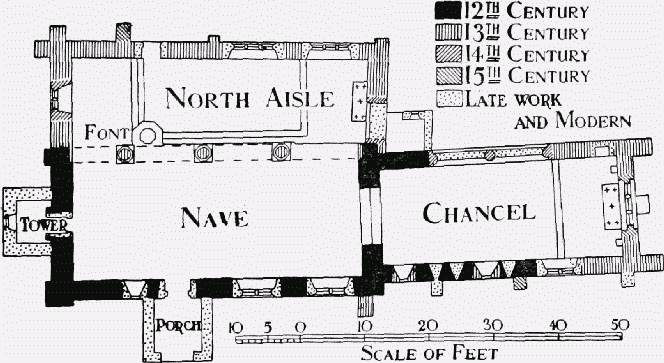
Plan of Kirkby Sigston Church
The communion plate consists of a cup with the London date letter for 1570 and cover with the York letter for 1635, a paten of about 1805 presented in 1875 by Thomas Atkinson, rector, a flagon of 1878, a pewter flagon and two pewter plates.
The registers begin in 1574.
Advowson
The church of Kirkby Sigston belonged from a very early date to the Prior and convent of Durham. It was taken from them in the late 11th century by Bishop Ralph Flambard, but was subsequently restored by his charter. (fn. 92a) An agreement was made in 1174 between the Archbishop of York and the Bishop of Durham, which acknowledged that jurisdiction in the church of Sigston had belonged to the Priors of Durham, and provided that the bishop should have the same jurisdiction in future. (fn. 93) The agreement was not respected by the successors of this archbishop, and in 1330 the Bishop of Durham appealed to the pope to support his jurisdiction in Sigston and elsewhere. (fn. 94) The advowson belonged to the prior and convent. A difficulty arose in 1344 as the result of a papal provision to the living. By arrangement with the prior Edward III claimed the patronage for one turn and made good his claim in his own courts. (fn. 95) He presented John de Halnaby to the vacant benefice, issuing a mandate to the sheriff and others to arrest anyone who intruded upon the church, 'as one Thomas de Carleton and others are now striving to do.' (fn. 96) Thomas de Carleton had been presented to the church by the pope, and was in peaceful possession until he was 'despoiled of the church by the Prior and John de Halnaby his kinsman,' for whom the prior procured the presentation from the king. (fn. 97) He presented a petition by which it is recorded that 'the king's conscience was deservedly stirred.' Thomas de Carleton was taken into the royal protection till further inquiries were made, (fn. 98) and was afterwards confirmed in the benefice. (fn. 99)
After this date the advowson remained in the possession of the prior and convent till the Dissolution. (fn. 100) The Crown then presented till 1642, when the advowson was granted to Lord Fauconberg. (fn. 1) He sold it in 1654 to John and William Turner, (fn. 2) and from that date it has followed the descent of the manor. (fn. 3) The present patron is Mr. C. R. Slingsby.
A chantry was founded in the parish church in 1343 by John Sigston for the daily celebration of divine service. Licence was given him to alienate a messuage and land for that purpose. (fn. 4) In 1424, however, it was found by inquisition that Sir John Sigston granted in mortmain without licence a messuage in Sigston to the chaplain of this chantry. The king therefore granted the premises to his informant, John Somerseth, 'for the defence of the kingdom of England.' (fn. 5)
In 1458 the chantry was refounded as that of John Sigston by Elizabeth Sywardby and her daughter Margaret wife of Geoffrey Pigot. (fn. 6) Elizabeth Sywardby left to it various ornaments (fn. 7) by will.
There are no endowed charities in Kirkby Sigston.
